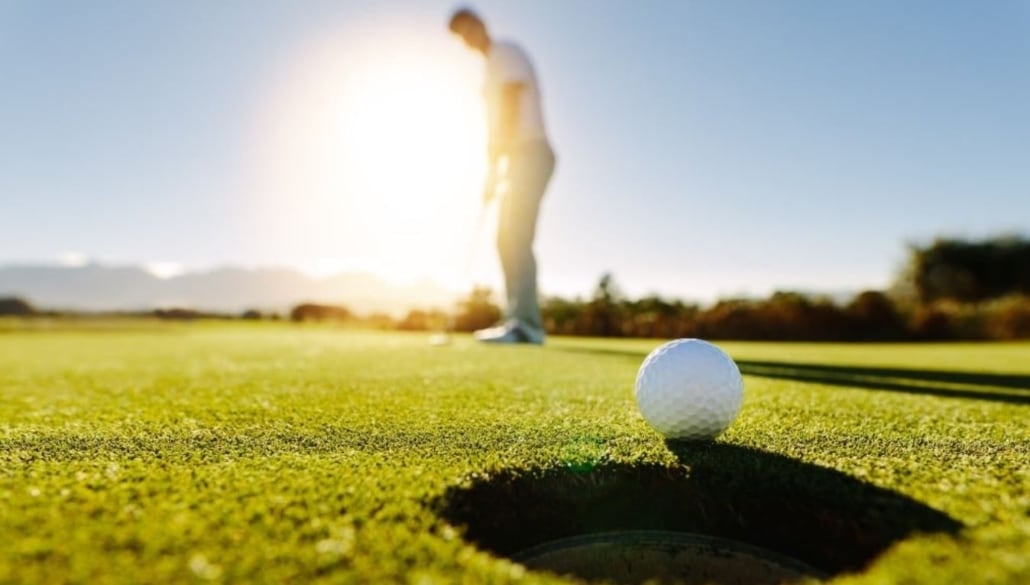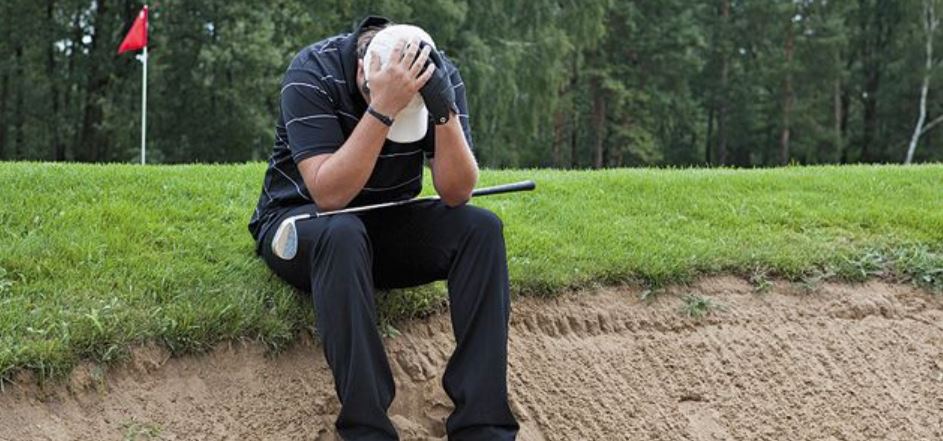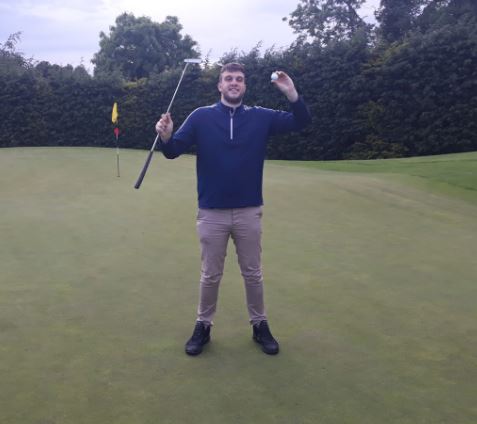How to Play Better Golf Under Pressure – Ultimate Tips and Guide

I remember my formative golf years as a youngster and the pressure on the first tee was almost unbearable. You know that it is a real possibility, you will hit a daisy cutter onto the 3rd hole fairway or even worse, take a complete air shot. As you get more serious a different type of performance anxiety can develop when playing tournaments or competitive rounds.
The truth is that, every single golfer has felt first tee nerves, if you haven’t then you have an issue. Golf is a sport that constantly tests your nerves and often, those who play best are purely the one who can control this best. If you can learn how to manage your emotions on the course, you will become a better golfer.
Today on the blog, we are going to give you some tips and strategies to help you on the course. Next time you feel your heart starting to pound, you will know what to do and how to perform under pressure.
What causes us to perform less well under pressure in golf?
Think of a time that you were nervous or under pressure, did your body tighten up? It almost certainly did, and this is a big problem for your golf performance. The first thing that happens is that you start to grip the club harder, this makes it harder to strike the ball poorly.
You will also find that you may start making poor decisions, this can make you feel more pressure. This is one of the main issues with golfing under pressure, it seems like a downward spiral. It’s time to take charge.
Is it all mental?

You can never underestimate the influence of the mental game on your golfing skills. Think of those rounds you play when everything works well, you feel confident, you know you won’t miss and you don’t. On bad days it seems that nothing goes well, that’s also your mind playing with you.
The golf course can be a lonely place when you’re not playing well. I have literally been in tears, as a grown man, on the course during a tournament having ‘lost my head’ in a tournament. Your mind can be your biggest ally and worst enemy on the course.
“Competitive golf is played mainly on a five-and-a-half-inch course, the space between your ears.”
Ben Hogan
5 Tips for overcoming nerves and performing better under pressure
Overcoming nerves takes exposure and experience, as you face this pressure more you become better at dealing with it. There are ways of fast-tracking this process and even making your game more pressure-proof. If you can add pressure during your practice sessions and when it doesn’t matter, then you will be more ready to deal with it when it does matter.
Below you will see some methods you can use both on and off the course. You can use some of these techniques to quickly calm yourself when things are getting too much or just make yourself feel the heat more often so you acclimatise to it. Read on to reinforce your game and get the most out of your skills.
1) Box Breathing
When you want to learn how to perform under pressure, there are few groups that know more about this than Special Forces soldiers. The first tip comes from them and it is a breathing technique you can use both on and off the course. Box breathing tricks your body into thinking that you are in a relaxed or ‘rest and digest’ state and it really calms you quickly.
To do this technique, you breathe in for four seconds, hold your breath for four seconds, breathe out for four seconds, hold your breath for four seconds then start again. A few rounds of this and you will be amazed at how much calmer you feel so quickly.
2) Visualisation

This is one that a lot of athletes use and it can be very powerful, if you’re sceptical, so was I, but it works. Your brain is an amazing organ and it can trick itself into thinking that it has been somewhere before, even if it hasn’t. This is something we, as golfers, can use to help our nerves.
Let’s say you get really bad first tee nerves at your club, try this. Sit, with no distractions and really commit to visualising standing up on the tee and hitting the perfect drive. This takes practice, but it will help you if you commit to doing it daily for a while, it’s like magic!
3) Adding pressure at the range
How many times do you go to the driving range and see people mindlessly trying to hit a driver as hard as they can? Start making it harder and you will reap benefits on the course. Go with a friend and make small bets to hit targets.
Play little games with yourself like, you can miss this flag left on this shot or you have to donate money to charity. There are many things you can do to add pressure on the range, just be present in every shot and treat it like a real shot.
4) Putt for dough
One great pressure drill for putting is what I call the ‘Death Spiral’. Get six balls and make a spiral away from the hole so that each putt gets longer, you want he first putt to be about three feet and the last one to be about eight feet. This is the range that can eliminate three putts so you want to get good at handling pressure in this range.
Now, you start with the ball closest to the hole, put tees beside each ball because you will probably need a few laps of this. You go through your pre-shot routine and try to hole the putts in order, if you miss you start again. Holing that final putt is tough on the nerves, especially if you’ve been there for a while.
5) Short game pressure
A drill that I use a lot has a double benefit, you get some added pressure and you hole more chips. When I’m doing a short game session I always finish with a target for the final portion of the practice. I don’t let myself leave until I have holed a certain number of chips.
The key here is that you have to stay strict on pre-shot routine and you cannot leave until you have holed the correct amount of shots. It is amazing how frustration, tension and pressure can build during this. Stay focussed, commit to the process and make the shots you need, I have been on the practice green until dark because of this!
6) Reframe the pressure, use it to your advantage
Do you ever wonder how the best athletes in the world are able to pull out miraculous moments time and time again just when they need it? Well one of the ways they are able to do this is that they have learned to love that moment. They want to be in that position and they thrive there.
This is clearly not something that comes quickly, however, all of this pressure is just your mind playing tricks on you. These feelings are there to protect us from danger, well we aren’t in any danger. The worst thing that is going to happen is you hit a bad golf shot, that’s annoying but it won’t hurt you.
7) Pre-shot routine magic
I have already mentioned the pre-shot routine, this is a huge tool in your game against pressure. The most important thing about a routine is that it is repeatable and makes you feel comfortable. It works because it gives you regularity and something to focus on even when the pressure is building.
You just work through your process and concentrate on that whilst focussing on the target. It helps you block out external distractions and prepare for your shot. There is a reason that every single top player in the world has a well-honed pre-shot routine.
8) Give yourself a break between shots
Golf is such a unique sport, you play your shot then have minutes to think before you play your next shot. This is prime time to get inside your own head and cause yourself some real trouble, let’s be honest, we have all done it. Do you really switch off between shots?
It is easy to do this when you’re playing with friends but how do you do it when you’re out on your own in a tournament. Well, golf courses are really nice places to spend your time, take time to appreciate the beauty of the course that you are on. Look around and take in your surroundings, really concentrate on the nature around you.
9) Watch your self-talk

Negative self-talk is the most effective self-talk there is, it always affects you badly. Trevor Moawad, a mental performance expert, suggests that minimising negative self-talk is more effective than increasing positive self-talk. Just thinking positively won’t make you hit that career shot around the trees but if you think negatively you can be sure that you won’t pull it off.
The way to think of the course is neutrally, another Moawad philosophy. Be objective about your situation, remember that the shots you have already played have no effect on the shots you are about to play, unless you allow it. Focus on the target and just think about putting the best swing on it as you can.
10) The post-shot routine
You hear about the importance of the pre-shot routine, we’ve already talked about it above, but you rarely hear about the post-shot. This is about having a process you go through so that you don’t get emotional after a shot. You need to react to it, be annoyed or delighted, but only for a set time.
Then, going through your process, you accept whatever has happened and switch off until the next shot. By walking to your next shot annoyed or even angry, you really increase the chance of following a bad shot with another one. This should never happen and a post-shot routine can help you avoid it.
Physical fitness – improve the body to help relieve pressure

Golf fitness is a growing area of interest for the average golfer and it really is something that every golfer can benefit from. By being in good physical shape, you can reduce fatigue and ensure one less thing to battle during your round. A tired body can cause mental mistakes and it can build pressure if you start hitting bad shots due to fatigue.
Another important thing about physical fitness is that it helps you control your heart rate. When you are feeling the pressure, a fitter person will be able to reduce their beat per minute faster so that they can feel calmer. Again, almost all top pros work hard on fitness now, you should too.
Post-round – don’t be a “but” guy
How many times have you been in the clubhouse after a round and asked someone how they played only to hear, “I hit it really well, but…”. For some reason, we golfers love to tell people about the bad shots we hit and not the good ones. You could come home with the best score you’ve ever had, you would still tell people the bad shots you hit.
Here’s something to try, it’s called the three-shot diary and it is a wonderful tool. After every round, good or bad, write down the three best shots you hit that day. Go into as much detail as you can and you will help reinforce those good feelings rather than bad ones.
Conclusion

To play good golf takes a strong mental resolve, the good news is that this is something we can all work and improve on. It takes time and conscious effort to build mental toughness and resolve to weather bad shots. However, you must always remember that a bad shot has no relation at all to the next shot, just start again from where ever it ends up.
Golf is a game that can be difficult to play under pressure but as you face pressure more often you become better at dealing with it. Start to get creative on how you add pressure to your practice and it will make you a better golfer. Be tough on yourself in practice so that you can be tough when it counts.



